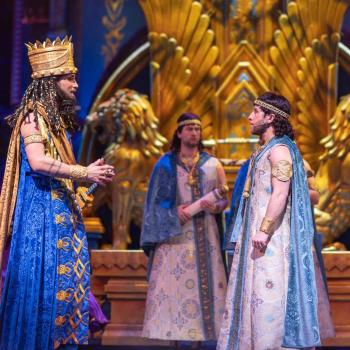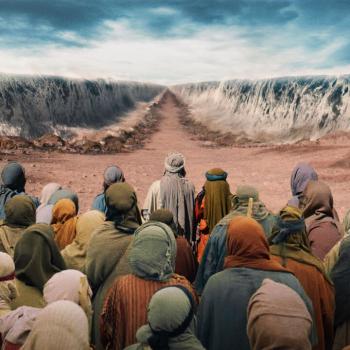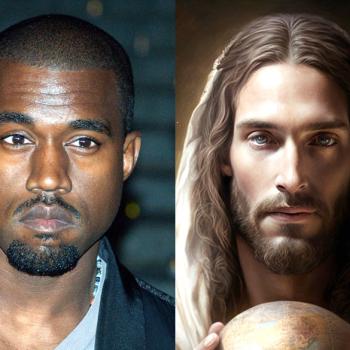I wrote the following a few years ago, and have not been able to farm it out anywhere. Other parts to follow in subsequent posts to this site.
For if anyone is a hearer of the word and not a doer, he is like a man who looks at his natural face in a mirror; for once he has looked at himself and gone away, he has immediately forgotten what kind of person he was (Jas. 1:23-24).
Deep in the pit of hell, the pilgrim Dante came across yet another chilling sight ?Ea man walking with his torso split open from chin to groin, so that ?his guts spilled out, with the heart/ and other vital parts, and the dirty sack/ that turns to s*** ( merda ) whatever the mouth gulps down.?ELike a motorist rubbernecking at an accident, Dante stared in fascinated horror, and the man began to speak:
?See how I tear myself!
See how Mahomet is deformed and torn!
In front of me, and weeping, Ali walks,
his face cleft from his chin to the crown?E( Inferno 28.22-33).
The surprise in this scene is not the gruesomeness of Mohammed?s punishment. A descendant of Crusaders, Dante would not give a second thought to the sensitivities of Muslims, nor did he regard Muslims as fellow-worshipers of the God of Abraham. The surprise is the place where this scene occurs, in the ninth Bolgia of Malebolgia, in the subcircle of hell reserved for schismatics. Mohammed is not among the idolaters or the pagans, but among sinners being punished for breaking off from the Christian church, all of whom, appropriately enough, have their bodies rent as retribution for rending the body of Christ.
In treating Mohammed as a Christian schismatic, Dante was not inventing a new perspective (he rarely did), but presenting views widespread in his time. Many in the Western medieval world believed that Mohammed himself had apostatized from Christianity, and some even believed he had once been a cardinal. Centuries before Dante, John of Damascus (675-749) treated Islam in the final section of his treatise de Haeresibus , calling it the ?heresy of the Ishmaelites.?EJohn wrote that Mohammed was influenced by an Arian monk named Bahira, who encouraged the spread of Islam by predicting that Mohammed would become a prophet.
Peter the Venerable, abbot of the famed abbey of Cluny during the twelfth century, hesitated over whether to call Islam a heresy or a form of paganism, ?for I see them, now in the manner of heretics, take certain things from the Christian faith and reject other things; then ?Ea thing which no heresy is described as ever having done ?Eacting as well as teaching according to pagan custom.?EYet, Peter wrote treatises with titles like Summa totius haeresis Saracenorum (?Summary of all the heresies of the Saracens?E and Liber contra sectam sive haeresim Saracenorum (?A Book against the Sect or Heresy of the Saracens?E, and he viewed Islam as a sum of all Christian heresies. According to Peter, Mohammed himself had been taught by a Nestorian monk named Sergius who ?made him a Nestorian Christian,?Eand Mohammed?s teaching was a mish-mash of Sabellianism, Nestorianism, Manicheanism, and Judaism. False teaching was bad enough, but Peter was equally concerned with Muslim practice. Even if, as Peter concedes, the Qur?an records truths about the prophets and Jesus, Muslims reject the sacraments, which is something that ?no one besides these heretics ever did.?E
These medieval treatments of Islam find little favor today, even among Christians, yet as a purely historical matter, the medieval accounts have some points in their favor. That Mohammed had contact with a Syrian monk is mentioned in the hadith, collections of Mohammed?s words and actions that serve for most Muslims as a second source of authority alongside the Qur?an. And it is clear that Mohammed had wider contact with Christians. One of the key themes of the Qur?an is a denial of the Trinity, since it is ?far from his glory?Efor Allah ?to beget a son?E(Sura 4.171; cf. 2.115; 5.73, 116; 6.101; 9.30-31; 18.4-5; 25.2; 112.3). More generally, Nestorian Christianity had by Mohammed?s time spread through Arabia, Syria, Iraq, Persia, and eastward as far as China, and Monophysite Christians had founded churches in Syria and Egypt. Prior to the Islamic conquest of the Middle East and North Africa, those areas were predominantly Christian, if often heretically Christian. It is, furthermore, a vast oversimplification to suggest that these Christians submitted to the superior force of the Islamic sword, since many Christians greeted the Arabian conquest as a liberation, and willingly converted to Islam. Whatever the experience of individuals, as a region and as a culture, the Middle East and North Africa became Islamic by abandoning Christendom. The medieval perspective is true to this extent: The Islamic world is not pagan but apostate.
In addition to highlighting important historical factors, the medieval account of Islam also has the virtue of being a theological account. For modern religious scholarship, Islam, Judaism, Hinduism, Christianity, and all the rest are variations on a single, more basic phenomenon called ?religion.?EBut this is worse than useless. For the church, Islam cannot be considered another variation on a universal religious impulse but must be understood theologically, and addressed as both a theological and practical challenge. The practical problem is obvious. Over a millennium ago, the Middle East and North Africa were Islamicized and Arabicized, and, though medieval Christians withstood Islam?s advance into Europe, Christianity has made scant progress in the Islamic world. Far from retreating, in recent decades Muslims have become a significant minority in Western Europe and the United States, and, of course, the rise of Islamism or radical Islam means that Islam has become a more direct threat to the West than at any time since Lepanto. Political difficulties aside, the practical question for the church is, What can we do to break through the apparently impenetrable boundary of Islam and ensure that the gospel will be heard and triumph?
The theological problem is equally daunting, and more fundamental. It can be put this way: Islam?s account of history has a place for Jesus and Christianity. To be sure, the Jesus of Islam is not the Jesus of the New Testament: He is not the divine Son incarnate, He was not crucified and raised (cf. Sura 4.157), and He is not reigning at the Father?s right hand. Still, the prophet Jesus has a place in Muslim ?redemptive history,?Eand this poses the challenge to Christians: Has Christian theology been able to locate Islam within its history? Luther and Hal Lindsey have little in common, but they have this: Both were able to find Islam in the penumbra of John?s Apocalypse. Dispensationalist and historicist views of Revelation fail on many counts, not least because of their marvelous elasticity, their capacity to discover in biblical prophecy explicit references to the Middle East threat du jour ?Eeveryone from Turks to Saddam Hussein, and no doubt bin Laden and John Walker Lindh as well. The failure of these approaches to prophecy only intensifies the question: Can Christians make theological sense of the persistence of Islam? Can we fit them into our story?
Though Islam does not meet any strict definition of ?heresy,?Ethe medieval idea of Islam as a Christian heresy or as an apostasy from Christendom provides some clues to answering that question. Following up those a few of those clues is the business of this paper.















